Business Project: Innovation, Change & Performance at Toll Logistics
VerifiedAdded on 2023/06/11
|16
|3864
|349
Project
AI Summary
This business project delves into enhancing innovation and managing change within an organization, specifically focusing on Toll Logistics warehousing. It addresses the need for change within the team to improve performance and foster innovation. The project covers cost-benefit analysis, creativity in innovation, organizational learning principles, quality management, continuous improvement models like Six Sigma and Plan-Do-Check-Act, and risk management processes. It further explores knowledge management systems, supply chain management components, and gap analysis. The SWOT analysis identifies strengths, weaknesses, opportunities, and threats to team performance, emphasizing areas for improvement such as supply chain, operations, and customer service. Change management processes are recommended to manage the team effectively and encourage innovative thinking.
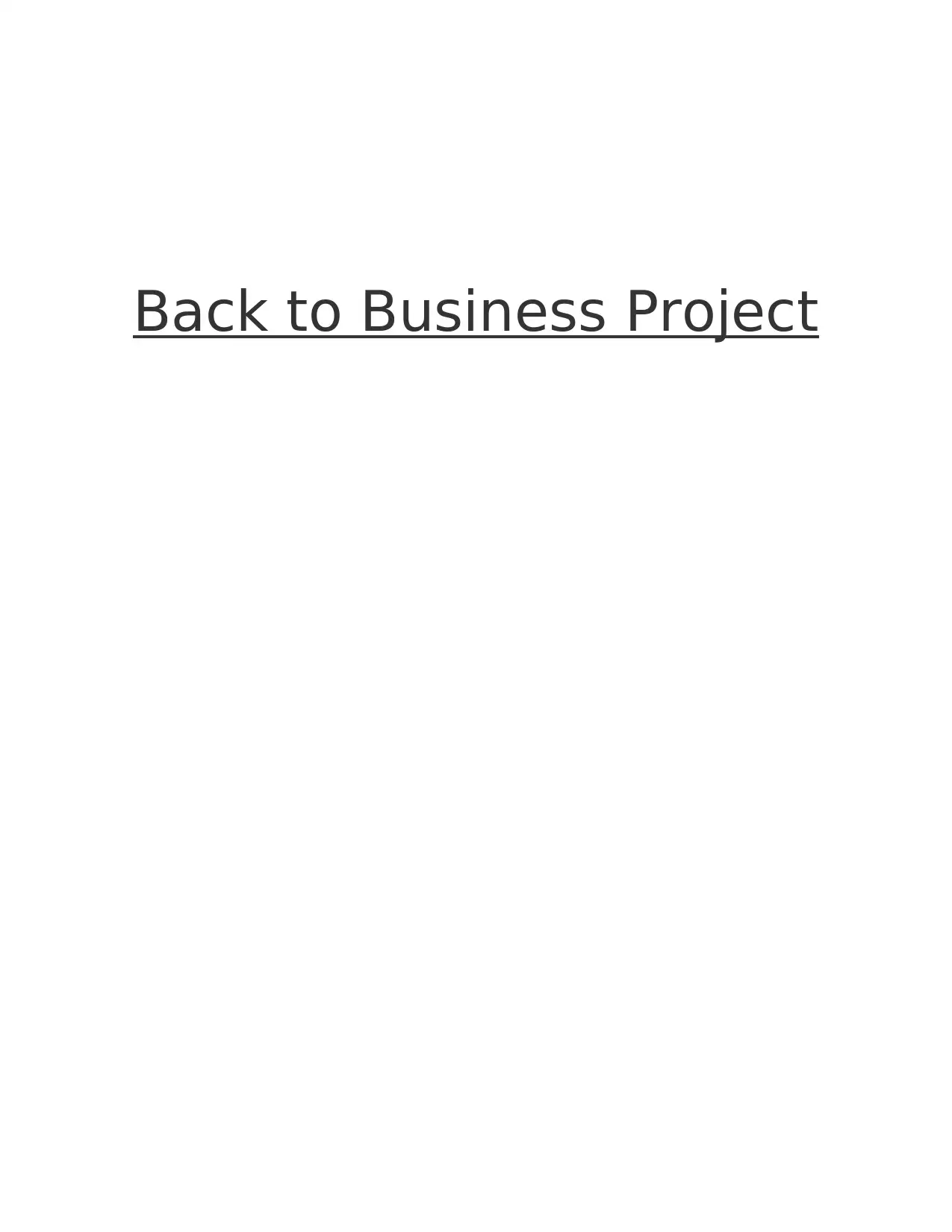
Back to Business Project
Secure Best Marks with AI Grader
Need help grading? Try our AI Grader for instant feedback on your assignments.
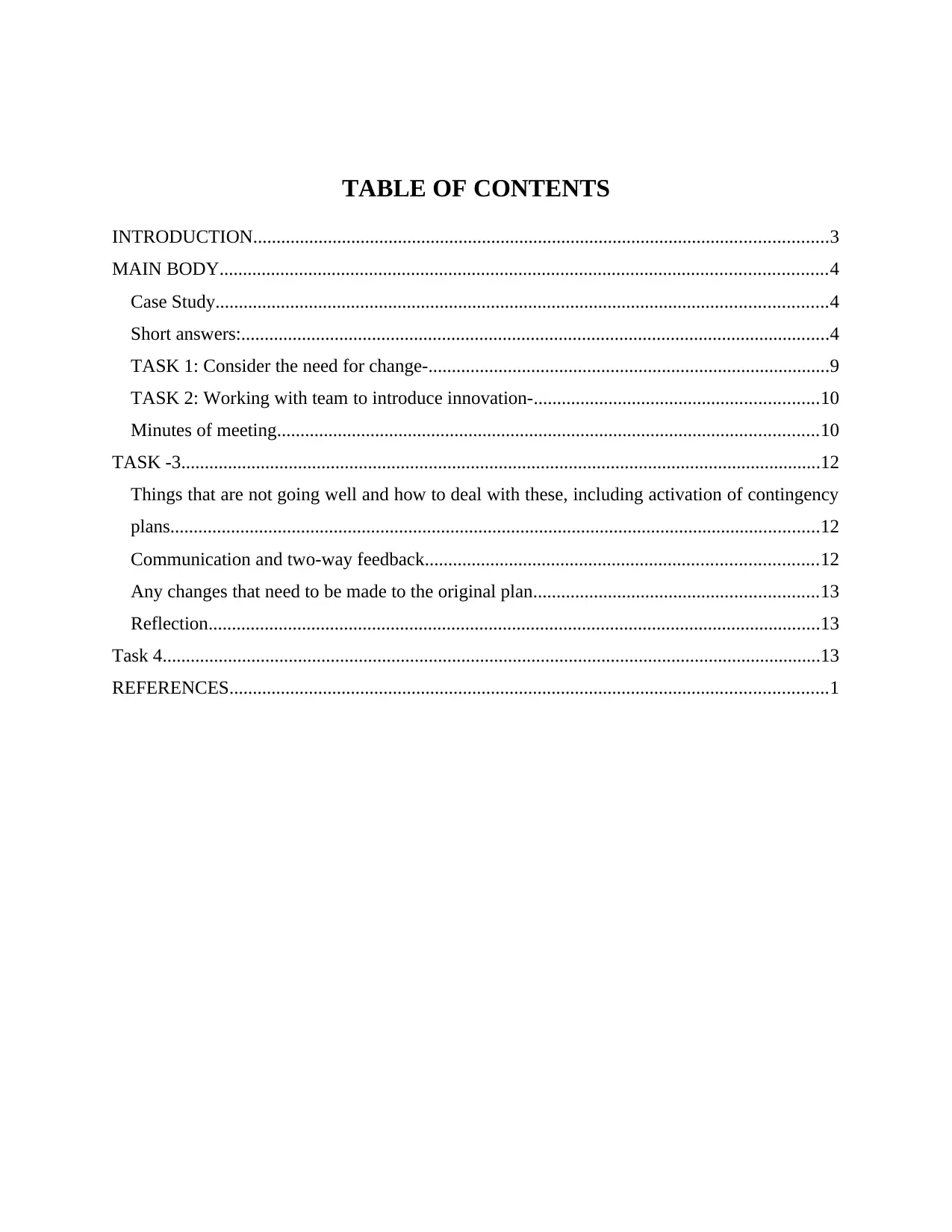
TABLE OF CONTENTS
INTRODUCTION...........................................................................................................................3
MAIN BODY..................................................................................................................................4
Case Study...................................................................................................................................4
Short answers:..............................................................................................................................4
TASK 1: Consider the need for change-......................................................................................9
TASK 2: Working with team to introduce innovation-.............................................................10
Minutes of meeting....................................................................................................................10
TASK -3.........................................................................................................................................12
Things that are not going well and how to deal with these, including activation of contingency
plans...........................................................................................................................................12
Communication and two-way feedback....................................................................................12
Any changes that need to be made to the original plan.............................................................13
Reflection...................................................................................................................................13
Task 4.............................................................................................................................................13
REFERENCES................................................................................................................................1
INTRODUCTION...........................................................................................................................3
MAIN BODY..................................................................................................................................4
Case Study...................................................................................................................................4
Short answers:..............................................................................................................................4
TASK 1: Consider the need for change-......................................................................................9
TASK 2: Working with team to introduce innovation-.............................................................10
Minutes of meeting....................................................................................................................10
TASK -3.........................................................................................................................................12
Things that are not going well and how to deal with these, including activation of contingency
plans...........................................................................................................................................12
Communication and two-way feedback....................................................................................12
Any changes that need to be made to the original plan.............................................................13
Reflection...................................................................................................................................13
Task 4.............................................................................................................................................13
REFERENCES................................................................................................................................1
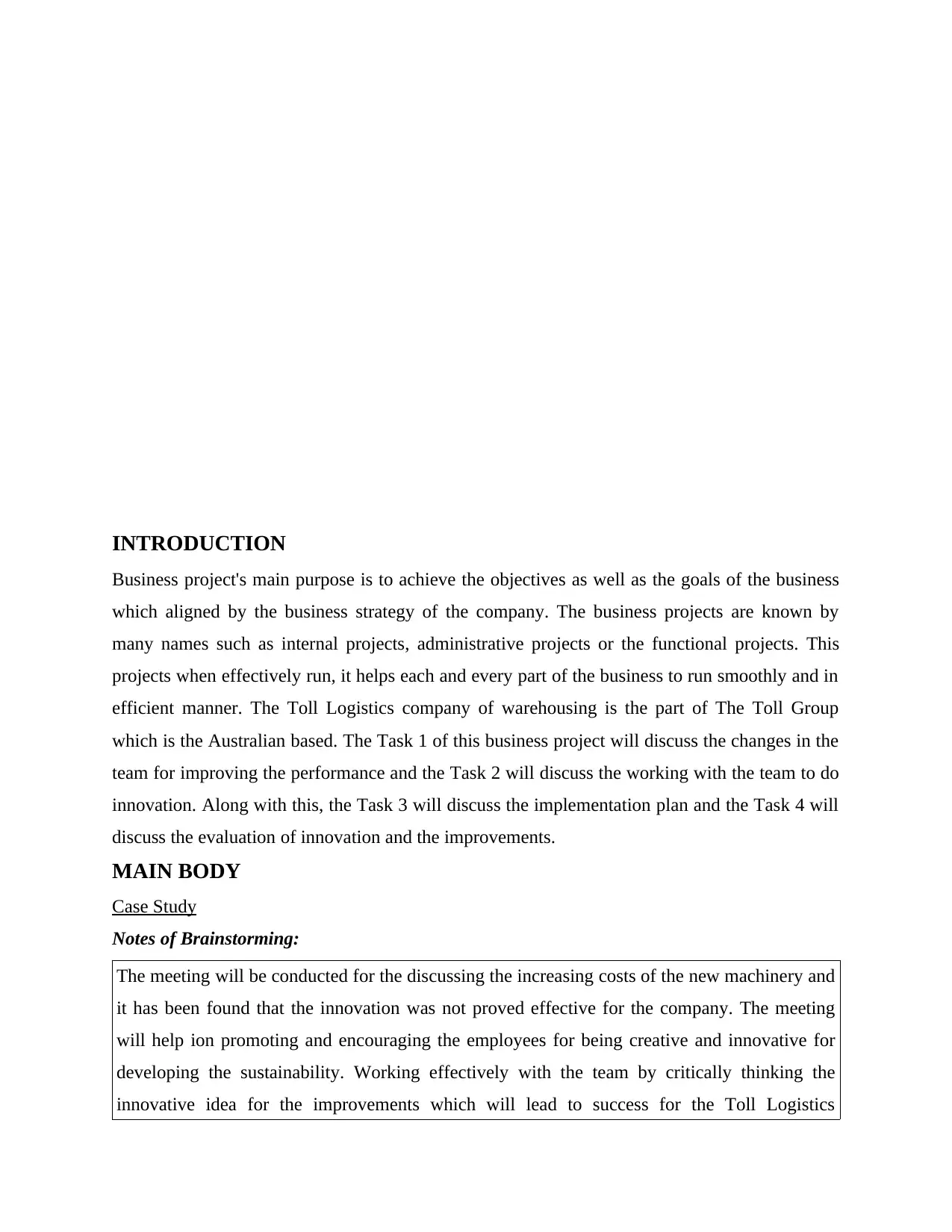
INTRODUCTION
Business project's main purpose is to achieve the objectives as well as the goals of the business
which aligned by the business strategy of the company. The business projects are known by
many names such as internal projects, administrative projects or the functional projects. This
projects when effectively run, it helps each and every part of the business to run smoothly and in
efficient manner. The Toll Logistics company of warehousing is the part of The Toll Group
which is the Australian based. The Task 1 of this business project will discuss the changes in the
team for improving the performance and the Task 2 will discuss the working with the team to do
innovation. Along with this, the Task 3 will discuss the implementation plan and the Task 4 will
discuss the evaluation of innovation and the improvements.
MAIN BODY
Case Study
Notes of Brainstorming:
The meeting will be conducted for the discussing the increasing costs of the new machinery and
it has been found that the innovation was not proved effective for the company. The meeting
will help ion promoting and encouraging the employees for being creative and innovative for
developing the sustainability. Working effectively with the team by critically thinking the
innovative idea for the improvements which will lead to success for the Toll Logistics
Business project's main purpose is to achieve the objectives as well as the goals of the business
which aligned by the business strategy of the company. The business projects are known by
many names such as internal projects, administrative projects or the functional projects. This
projects when effectively run, it helps each and every part of the business to run smoothly and in
efficient manner. The Toll Logistics company of warehousing is the part of The Toll Group
which is the Australian based. The Task 1 of this business project will discuss the changes in the
team for improving the performance and the Task 2 will discuss the working with the team to do
innovation. Along with this, the Task 3 will discuss the implementation plan and the Task 4 will
discuss the evaluation of innovation and the improvements.
MAIN BODY
Case Study
Notes of Brainstorming:
The meeting will be conducted for the discussing the increasing costs of the new machinery and
it has been found that the innovation was not proved effective for the company. The meeting
will help ion promoting and encouraging the employees for being creative and innovative for
developing the sustainability. Working effectively with the team by critically thinking the
innovative idea for the improvements which will lead to success for the Toll Logistics
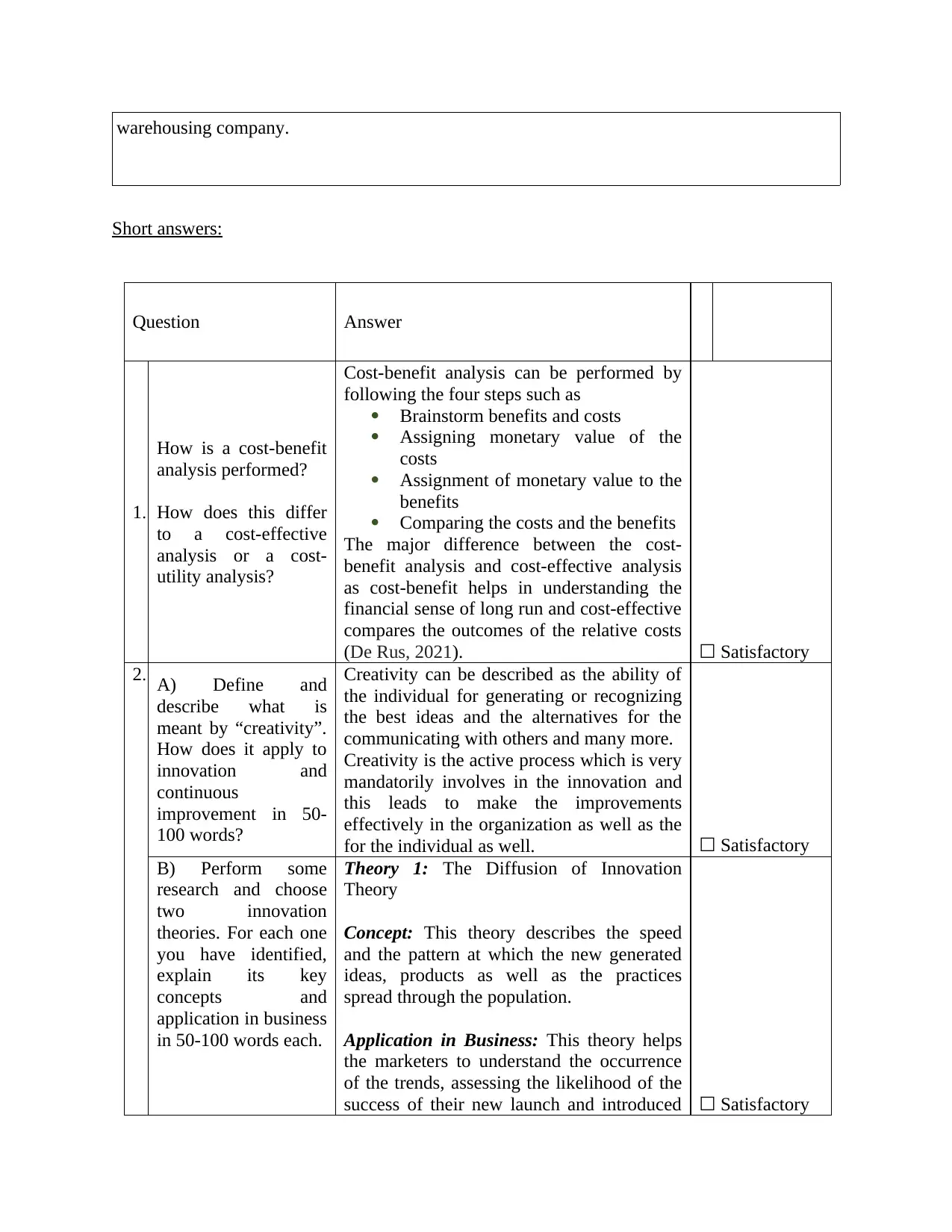
warehousing company.
Short answers:
Question Answer
1.
How is a cost-benefit
analysis performed?
How does this differ
to a cost-effective
analysis or a cost-
utility analysis?
Cost-benefit analysis can be performed by
following the four steps such as
Brainstorm benefits and costs
Assigning monetary value of the
costs
Assignment of monetary value to the
benefits
Comparing the costs and the benefits
The major difference between the cost-
benefit analysis and cost-effective analysis
as cost-benefit helps in understanding the
financial sense of long run and cost-effective
compares the outcomes of the relative costs
(De Rus, 2021). ☐ Satisfactory
2. A) Define and
describe what is
meant by “creativity”.
How does it apply to
innovation and
continuous
improvement in 50-
100 words?
Creativity can be described as the ability of
the individual for generating or recognizing
the best ideas and the alternatives for the
communicating with others and many more.
Creativity is the active process which is very
mandatorily involves in the innovation and
this leads to make the improvements
effectively in the organization as well as the
for the individual as well. ☐ Satisfactory
B) Perform some
research and choose
two innovation
theories. For each one
you have identified,
explain its key
concepts and
application in business
in 50-100 words each.
Theory 1: The Diffusion of Innovation
Theory
Concept: This theory describes the speed
and the pattern at which the new generated
ideas, products as well as the practices
spread through the population.
Application in Business: This theory helps
the marketers to understand the occurrence
of the trends, assessing the likelihood of the
success of their new launch and introduced ☐ Satisfactory
Short answers:
Question Answer
1.
How is a cost-benefit
analysis performed?
How does this differ
to a cost-effective
analysis or a cost-
utility analysis?
Cost-benefit analysis can be performed by
following the four steps such as
Brainstorm benefits and costs
Assigning monetary value of the
costs
Assignment of monetary value to the
benefits
Comparing the costs and the benefits
The major difference between the cost-
benefit analysis and cost-effective analysis
as cost-benefit helps in understanding the
financial sense of long run and cost-effective
compares the outcomes of the relative costs
(De Rus, 2021). ☐ Satisfactory
2. A) Define and
describe what is
meant by “creativity”.
How does it apply to
innovation and
continuous
improvement in 50-
100 words?
Creativity can be described as the ability of
the individual for generating or recognizing
the best ideas and the alternatives for the
communicating with others and many more.
Creativity is the active process which is very
mandatorily involves in the innovation and
this leads to make the improvements
effectively in the organization as well as the
for the individual as well. ☐ Satisfactory
B) Perform some
research and choose
two innovation
theories. For each one
you have identified,
explain its key
concepts and
application in business
in 50-100 words each.
Theory 1: The Diffusion of Innovation
Theory
Concept: This theory describes the speed
and the pattern at which the new generated
ideas, products as well as the practices
spread through the population.
Application in Business: This theory helps
the marketers to understand the occurrence
of the trends, assessing the likelihood of the
success of their new launch and introduced ☐ Satisfactory
Secure Best Marks with AI Grader
Need help grading? Try our AI Grader for instant feedback on your assignments.
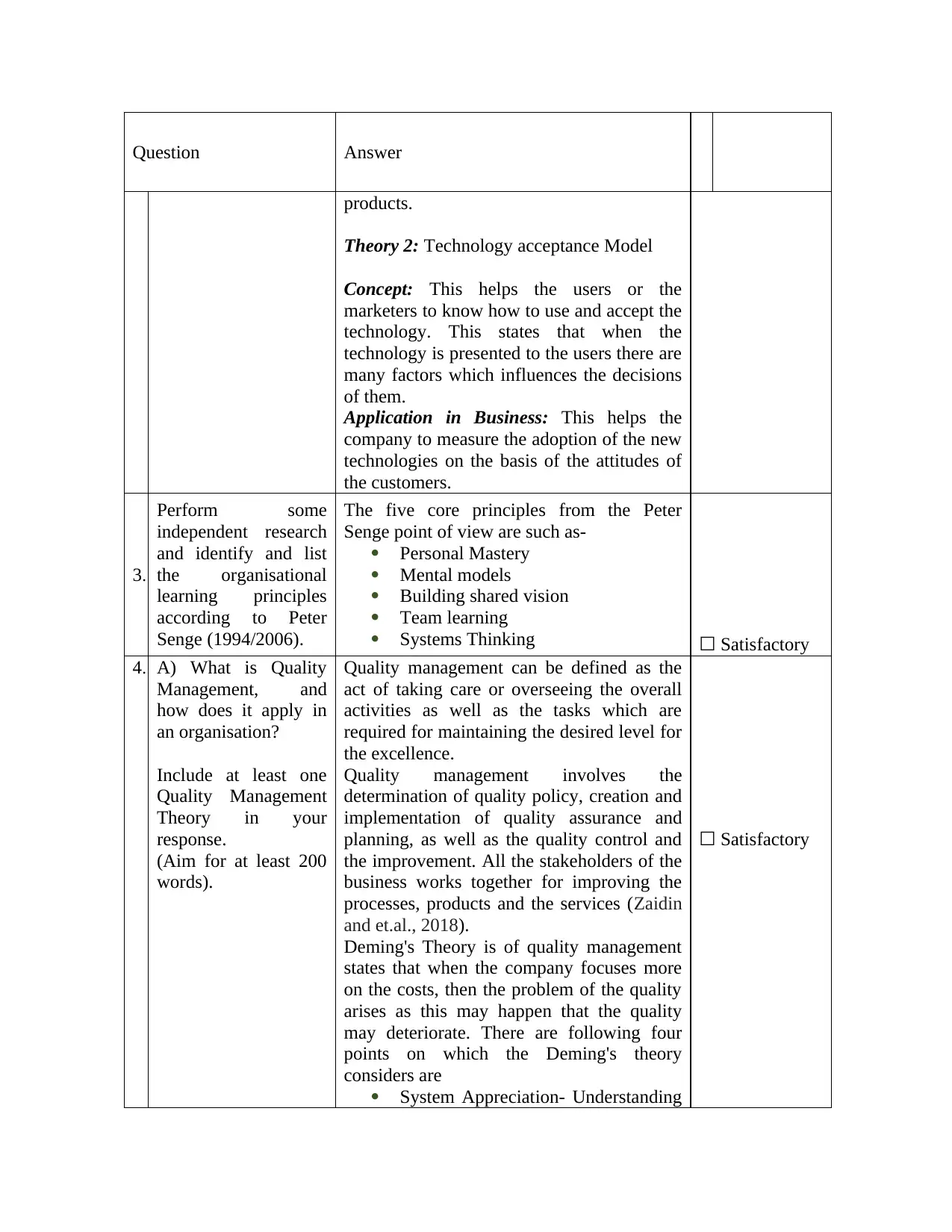
Question Answer
products.
Theory 2: Technology acceptance Model
Concept: This helps the users or the
marketers to know how to use and accept the
technology. This states that when the
technology is presented to the users there are
many factors which influences the decisions
of them.
Application in Business: This helps the
company to measure the adoption of the new
technologies on the basis of the attitudes of
the customers.
3.
Perform some
independent research
and identify and list
the organisational
learning principles
according to Peter
Senge (1994/2006).
The five core principles from the Peter
Senge point of view are such as-
Personal Mastery
Mental models
Building shared vision
Team learning
Systems Thinking ☐ Satisfactory
4. A) What is Quality
Management, and
how does it apply in
an organisation?
Include at least one
Quality Management
Theory in your
response.
(Aim for at least 200
words).
Quality management can be defined as the
act of taking care or overseeing the overall
activities as well as the tasks which are
required for maintaining the desired level for
the excellence.
Quality management involves the
determination of quality policy, creation and
implementation of quality assurance and
planning, as well as the quality control and
the improvement. All the stakeholders of the
business works together for improving the
processes, products and the services (Zaidin
and et.al., 2018).
Deming's Theory is of quality management
states that when the company focuses more
on the costs, then the problem of the quality
arises as this may happen that the quality
may deteriorate. There are following four
points on which the Deming's theory
considers are
System Appreciation- Understanding
☐ Satisfactory
products.
Theory 2: Technology acceptance Model
Concept: This helps the users or the
marketers to know how to use and accept the
technology. This states that when the
technology is presented to the users there are
many factors which influences the decisions
of them.
Application in Business: This helps the
company to measure the adoption of the new
technologies on the basis of the attitudes of
the customers.
3.
Perform some
independent research
and identify and list
the organisational
learning principles
according to Peter
Senge (1994/2006).
The five core principles from the Peter
Senge point of view are such as-
Personal Mastery
Mental models
Building shared vision
Team learning
Systems Thinking ☐ Satisfactory
4. A) What is Quality
Management, and
how does it apply in
an organisation?
Include at least one
Quality Management
Theory in your
response.
(Aim for at least 200
words).
Quality management can be defined as the
act of taking care or overseeing the overall
activities as well as the tasks which are
required for maintaining the desired level for
the excellence.
Quality management involves the
determination of quality policy, creation and
implementation of quality assurance and
planning, as well as the quality control and
the improvement. All the stakeholders of the
business works together for improving the
processes, products and the services (Zaidin
and et.al., 2018).
Deming's Theory is of quality management
states that when the company focuses more
on the costs, then the problem of the quality
arises as this may happen that the quality
may deteriorate. There are following four
points on which the Deming's theory
considers are
System Appreciation- Understanding
☐ Satisfactory
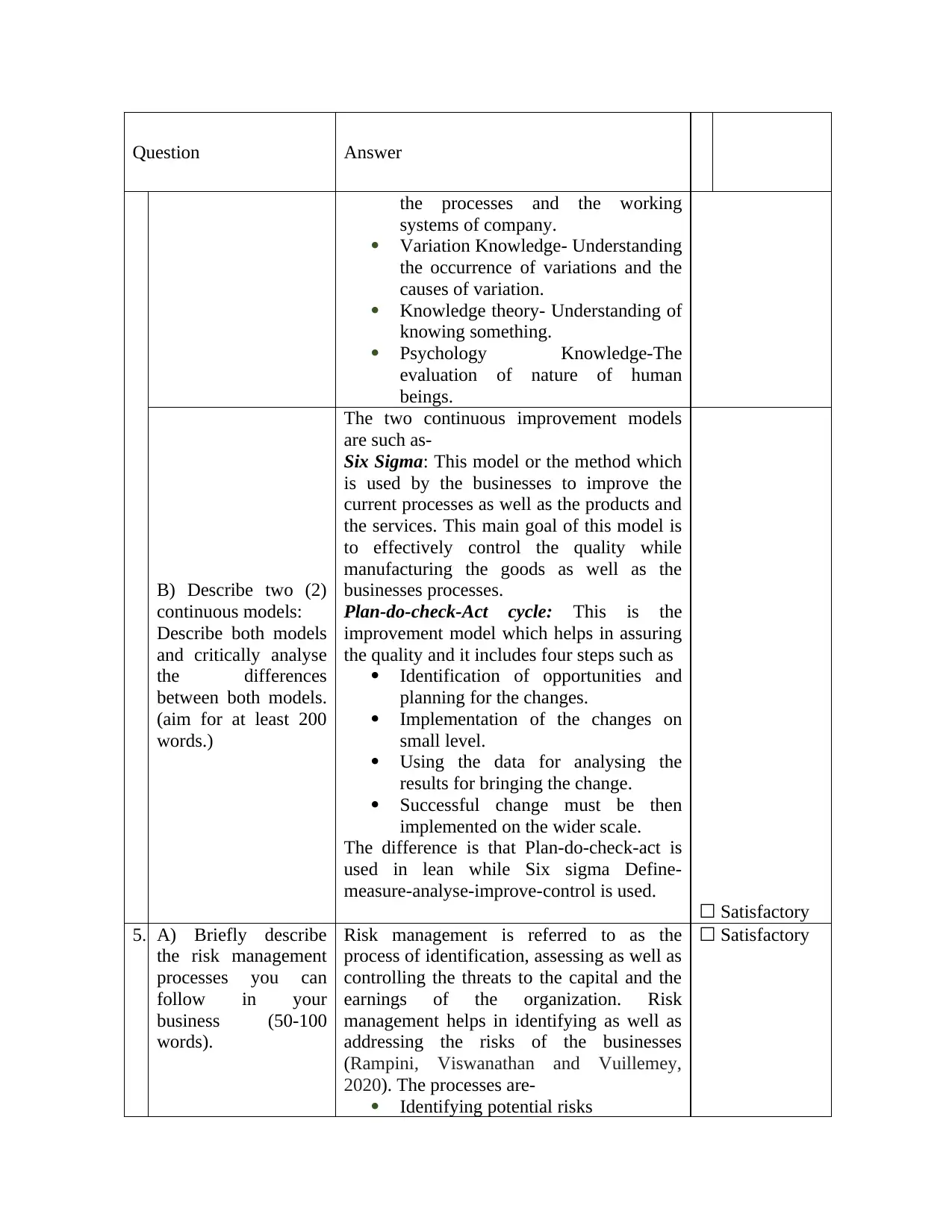
Question Answer
the processes and the working
systems of company.
Variation Knowledge- Understanding
the occurrence of variations and the
causes of variation.
Knowledge theory- Understanding of
knowing something.
Psychology Knowledge-The
evaluation of nature of human
beings.
B) Describe two (2)
continuous models:
Describe both models
and critically analyse
the differences
between both models.
(aim for at least 200
words.)
The two continuous improvement models
are such as-
Six Sigma: This model or the method which
is used by the businesses to improve the
current processes as well as the products and
the services. This main goal of this model is
to effectively control the quality while
manufacturing the goods as well as the
businesses processes.
Plan-do-check-Act cycle: This is the
improvement model which helps in assuring
the quality and it includes four steps such as
Identification of opportunities and
planning for the changes.
Implementation of the changes on
small level.
Using the data for analysing the
results for bringing the change.
Successful change must be then
implemented on the wider scale.
The difference is that Plan-do-check-act is
used in lean while Six sigma Define-
measure-analyse-improve-control is used.
☐ Satisfactory
5. A) Briefly describe
the risk management
processes you can
follow in your
business (50-100
words).
Risk management is referred to as the
process of identification, assessing as well as
controlling the threats to the capital and the
earnings of the organization. Risk
management helps in identifying as well as
addressing the risks of the businesses
(Rampini, Viswanathan and Vuillemey,
2020). The processes are-
Identifying potential risks
☐ Satisfactory
the processes and the working
systems of company.
Variation Knowledge- Understanding
the occurrence of variations and the
causes of variation.
Knowledge theory- Understanding of
knowing something.
Psychology Knowledge-The
evaluation of nature of human
beings.
B) Describe two (2)
continuous models:
Describe both models
and critically analyse
the differences
between both models.
(aim for at least 200
words.)
The two continuous improvement models
are such as-
Six Sigma: This model or the method which
is used by the businesses to improve the
current processes as well as the products and
the services. This main goal of this model is
to effectively control the quality while
manufacturing the goods as well as the
businesses processes.
Plan-do-check-Act cycle: This is the
improvement model which helps in assuring
the quality and it includes four steps such as
Identification of opportunities and
planning for the changes.
Implementation of the changes on
small level.
Using the data for analysing the
results for bringing the change.
Successful change must be then
implemented on the wider scale.
The difference is that Plan-do-check-act is
used in lean while Six sigma Define-
measure-analyse-improve-control is used.
☐ Satisfactory
5. A) Briefly describe
the risk management
processes you can
follow in your
business (50-100
words).
Risk management is referred to as the
process of identification, assessing as well as
controlling the threats to the capital and the
earnings of the organization. Risk
management helps in identifying as well as
addressing the risks of the businesses
(Rampini, Viswanathan and Vuillemey,
2020). The processes are-
Identifying potential risks
☐ Satisfactory
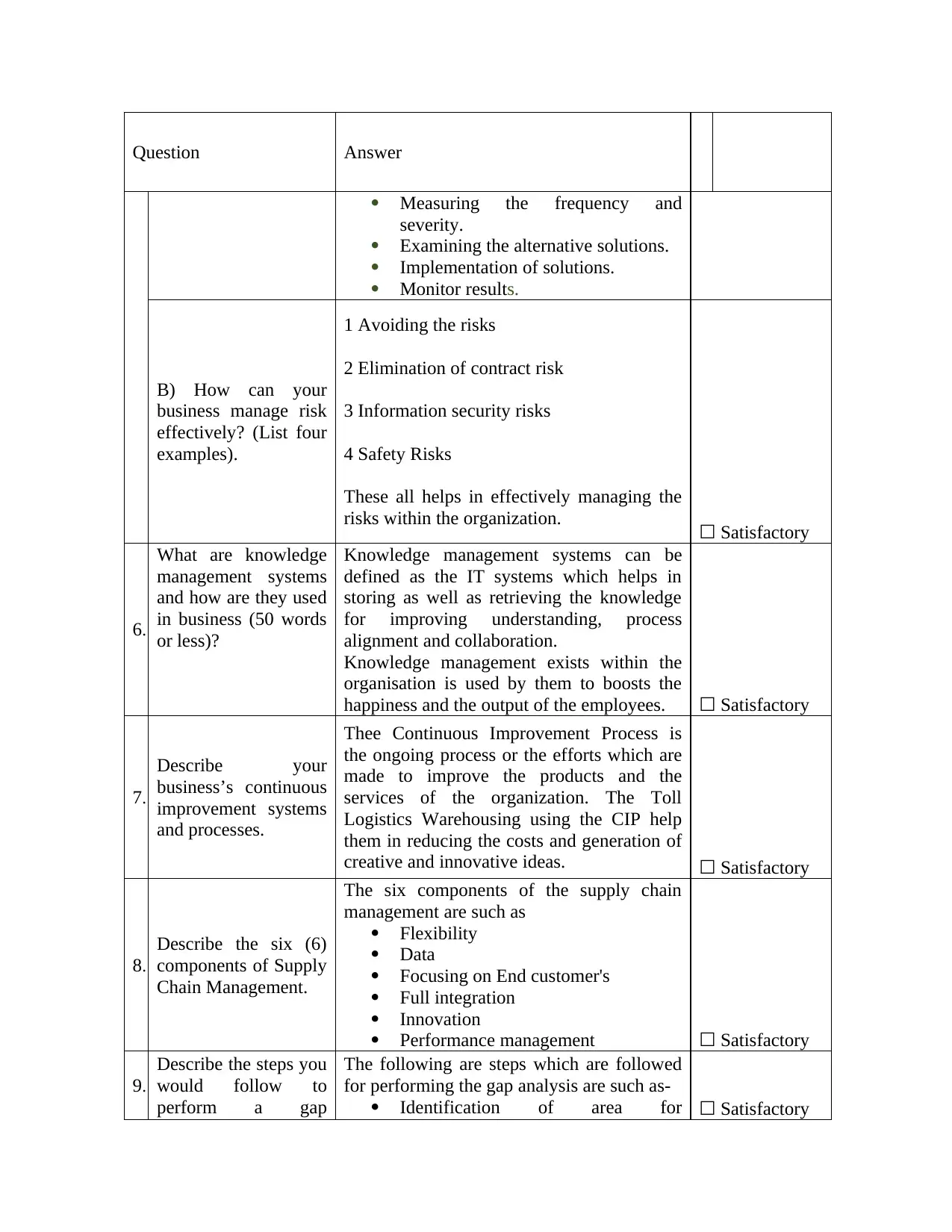
Question Answer
Measuring the frequency and
severity.
Examining the alternative solutions.
Implementation of solutions.
Monitor results.
B) How can your
business manage risk
effectively? (List four
examples).
1 Avoiding the risks
2 Elimination of contract risk
3 Information security risks
4 Safety Risks
These all helps in effectively managing the
risks within the organization. ☐ Satisfactory
6.
What are knowledge
management systems
and how are they used
in business (50 words
or less)?
Knowledge management systems can be
defined as the IT systems which helps in
storing as well as retrieving the knowledge
for improving understanding, process
alignment and collaboration.
Knowledge management exists within the
organisation is used by them to boosts the
happiness and the output of the employees. ☐ Satisfactory
7.
Describe your
business’s continuous
improvement systems
and processes.
Thee Continuous Improvement Process is
the ongoing process or the efforts which are
made to improve the products and the
services of the organization. The Toll
Logistics Warehousing using the CIP help
them in reducing the costs and generation of
creative and innovative ideas. ☐ Satisfactory
8.
Describe the six (6)
components of Supply
Chain Management.
The six components of the supply chain
management are such as
Flexibility
Data
Focusing on End customer's
Full integration
Innovation
Performance management ☐ Satisfactory
9.
Describe the steps you
would follow to
perform a gap
The following are steps which are followed
for performing the gap analysis are such as-
Identification of area for ☐ Satisfactory
Measuring the frequency and
severity.
Examining the alternative solutions.
Implementation of solutions.
Monitor results.
B) How can your
business manage risk
effectively? (List four
examples).
1 Avoiding the risks
2 Elimination of contract risk
3 Information security risks
4 Safety Risks
These all helps in effectively managing the
risks within the organization. ☐ Satisfactory
6.
What are knowledge
management systems
and how are they used
in business (50 words
or less)?
Knowledge management systems can be
defined as the IT systems which helps in
storing as well as retrieving the knowledge
for improving understanding, process
alignment and collaboration.
Knowledge management exists within the
organisation is used by them to boosts the
happiness and the output of the employees. ☐ Satisfactory
7.
Describe your
business’s continuous
improvement systems
and processes.
Thee Continuous Improvement Process is
the ongoing process or the efforts which are
made to improve the products and the
services of the organization. The Toll
Logistics Warehousing using the CIP help
them in reducing the costs and generation of
creative and innovative ideas. ☐ Satisfactory
8.
Describe the six (6)
components of Supply
Chain Management.
The six components of the supply chain
management are such as
Flexibility
Data
Focusing on End customer's
Full integration
Innovation
Performance management ☐ Satisfactory
9.
Describe the steps you
would follow to
perform a gap
The following are steps which are followed
for performing the gap analysis are such as-
Identification of area for ☐ Satisfactory
Paraphrase This Document
Need a fresh take? Get an instant paraphrase of this document with our AI Paraphraser
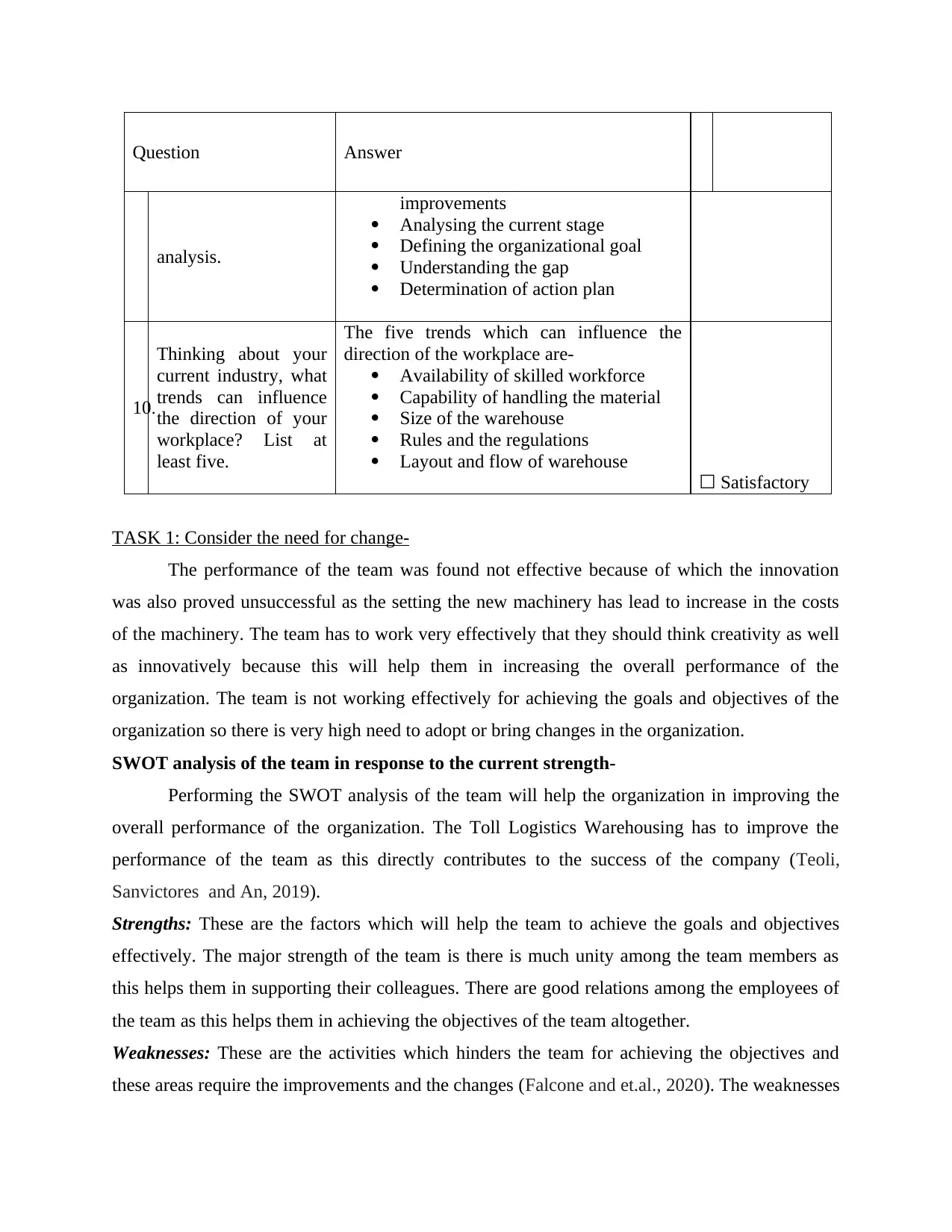
Question Answer
analysis.
improvements
Analysing the current stage
Defining the organizational goal
Understanding the gap
Determination of action plan
10.
Thinking about your
current industry, what
trends can influence
the direction of your
workplace? List at
least five.
The five trends which can influence the
direction of the workplace are-
Availability of skilled workforce
Capability of handling the material
Size of the warehouse
Rules and the regulations
Layout and flow of warehouse
☐ Satisfactory
TASK 1: Consider the need for change-
The performance of the team was found not effective because of which the innovation
was also proved unsuccessful as the setting the new machinery has lead to increase in the costs
of the machinery. The team has to work very effectively that they should think creativity as well
as innovatively because this will help them in increasing the overall performance of the
organization. The team is not working effectively for achieving the goals and objectives of the
organization so there is very high need to adopt or bring changes in the organization.
SWOT analysis of the team in response to the current strength-
Performing the SWOT analysis of the team will help the organization in improving the
overall performance of the organization. The Toll Logistics Warehousing has to improve the
performance of the team as this directly contributes to the success of the company (Teoli,
Sanvictores and An, 2019).
Strengths: These are the factors which will help the team to achieve the goals and objectives
effectively. The major strength of the team is there is much unity among the team members as
this helps them in supporting their colleagues. There are good relations among the employees of
the team as this helps them in achieving the objectives of the team altogether.
Weaknesses: These are the activities which hinders the team for achieving the objectives and
these areas require the improvements and the changes (Falcone and et.al., 2020). The weaknesses
analysis.
improvements
Analysing the current stage
Defining the organizational goal
Understanding the gap
Determination of action plan
10.
Thinking about your
current industry, what
trends can influence
the direction of your
workplace? List at
least five.
The five trends which can influence the
direction of the workplace are-
Availability of skilled workforce
Capability of handling the material
Size of the warehouse
Rules and the regulations
Layout and flow of warehouse
☐ Satisfactory
TASK 1: Consider the need for change-
The performance of the team was found not effective because of which the innovation
was also proved unsuccessful as the setting the new machinery has lead to increase in the costs
of the machinery. The team has to work very effectively that they should think creativity as well
as innovatively because this will help them in increasing the overall performance of the
organization. The team is not working effectively for achieving the goals and objectives of the
organization so there is very high need to adopt or bring changes in the organization.
SWOT analysis of the team in response to the current strength-
Performing the SWOT analysis of the team will help the organization in improving the
overall performance of the organization. The Toll Logistics Warehousing has to improve the
performance of the team as this directly contributes to the success of the company (Teoli,
Sanvictores and An, 2019).
Strengths: These are the factors which will help the team to achieve the goals and objectives
effectively. The major strength of the team is there is much unity among the team members as
this helps them in supporting their colleagues. There are good relations among the employees of
the team as this helps them in achieving the objectives of the team altogether.
Weaknesses: These are the activities which hinders the team for achieving the objectives and
these areas require the improvements and the changes (Falcone and et.al., 2020). The weaknesses
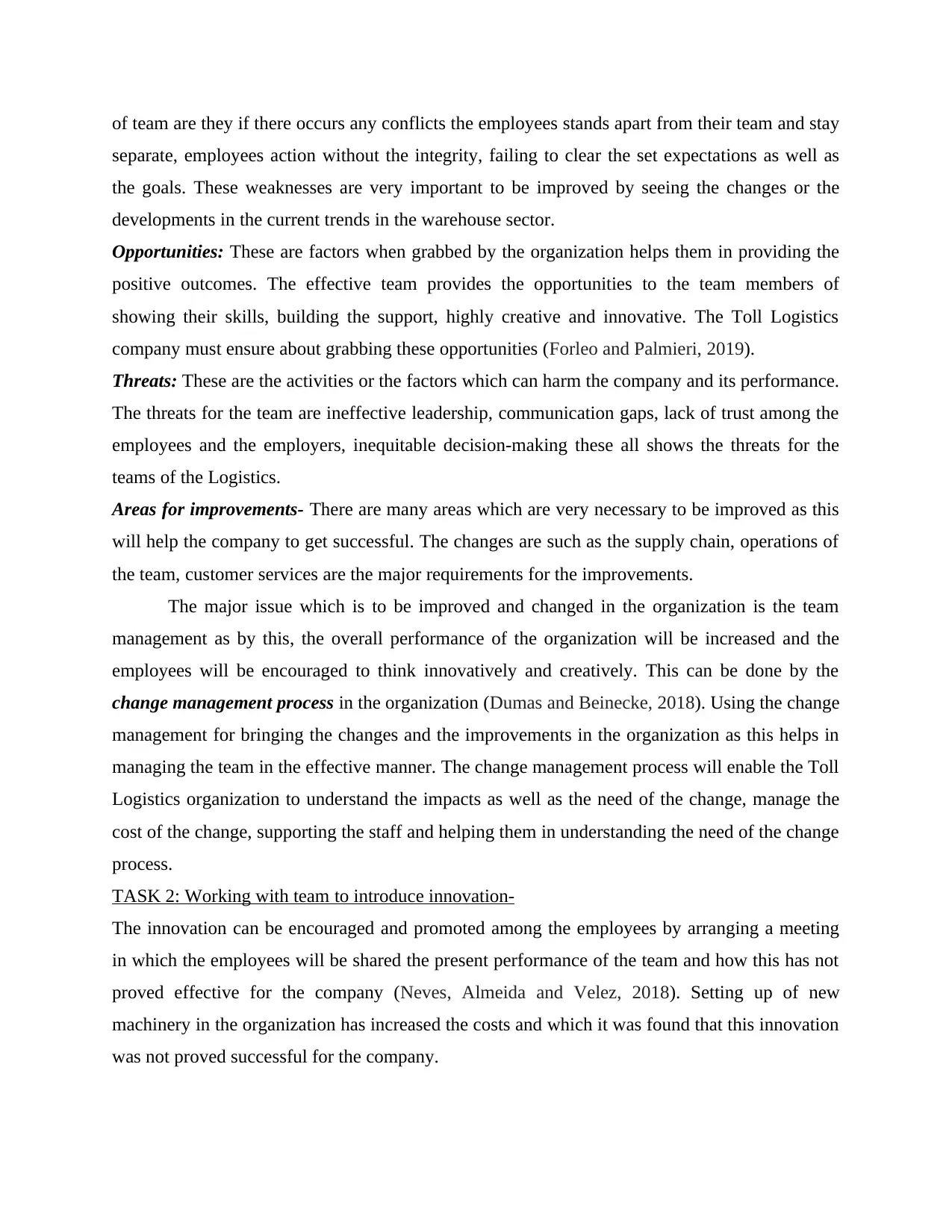
of team are they if there occurs any conflicts the employees stands apart from their team and stay
separate, employees action without the integrity, failing to clear the set expectations as well as
the goals. These weaknesses are very important to be improved by seeing the changes or the
developments in the current trends in the warehouse sector.
Opportunities: These are factors when grabbed by the organization helps them in providing the
positive outcomes. The effective team provides the opportunities to the team members of
showing their skills, building the support, highly creative and innovative. The Toll Logistics
company must ensure about grabbing these opportunities (Forleo and Palmieri, 2019).
Threats: These are the activities or the factors which can harm the company and its performance.
The threats for the team are ineffective leadership, communication gaps, lack of trust among the
employees and the employers, inequitable decision-making these all shows the threats for the
teams of the Logistics.
Areas for improvements- There are many areas which are very necessary to be improved as this
will help the company to get successful. The changes are such as the supply chain, operations of
the team, customer services are the major requirements for the improvements.
The major issue which is to be improved and changed in the organization is the team
management as by this, the overall performance of the organization will be increased and the
employees will be encouraged to think innovatively and creatively. This can be done by the
change management process in the organization (Dumas and Beinecke, 2018). Using the change
management for bringing the changes and the improvements in the organization as this helps in
managing the team in the effective manner. The change management process will enable the Toll
Logistics organization to understand the impacts as well as the need of the change, manage the
cost of the change, supporting the staff and helping them in understanding the need of the change
process.
TASK 2: Working with team to introduce innovation-
The innovation can be encouraged and promoted among the employees by arranging a meeting
in which the employees will be shared the present performance of the team and how this has not
proved effective for the company (Neves, Almeida and Velez, 2018). Setting up of new
machinery in the organization has increased the costs and which it was found that this innovation
was not proved successful for the company.
separate, employees action without the integrity, failing to clear the set expectations as well as
the goals. These weaknesses are very important to be improved by seeing the changes or the
developments in the current trends in the warehouse sector.
Opportunities: These are factors when grabbed by the organization helps them in providing the
positive outcomes. The effective team provides the opportunities to the team members of
showing their skills, building the support, highly creative and innovative. The Toll Logistics
company must ensure about grabbing these opportunities (Forleo and Palmieri, 2019).
Threats: These are the activities or the factors which can harm the company and its performance.
The threats for the team are ineffective leadership, communication gaps, lack of trust among the
employees and the employers, inequitable decision-making these all shows the threats for the
teams of the Logistics.
Areas for improvements- There are many areas which are very necessary to be improved as this
will help the company to get successful. The changes are such as the supply chain, operations of
the team, customer services are the major requirements for the improvements.
The major issue which is to be improved and changed in the organization is the team
management as by this, the overall performance of the organization will be increased and the
employees will be encouraged to think innovatively and creatively. This can be done by the
change management process in the organization (Dumas and Beinecke, 2018). Using the change
management for bringing the changes and the improvements in the organization as this helps in
managing the team in the effective manner. The change management process will enable the Toll
Logistics organization to understand the impacts as well as the need of the change, manage the
cost of the change, supporting the staff and helping them in understanding the need of the change
process.
TASK 2: Working with team to introduce innovation-
The innovation can be encouraged and promoted among the employees by arranging a meeting
in which the employees will be shared the present performance of the team and how this has not
proved effective for the company (Neves, Almeida and Velez, 2018). Setting up of new
machinery in the organization has increased the costs and which it was found that this innovation
was not proved successful for the company.
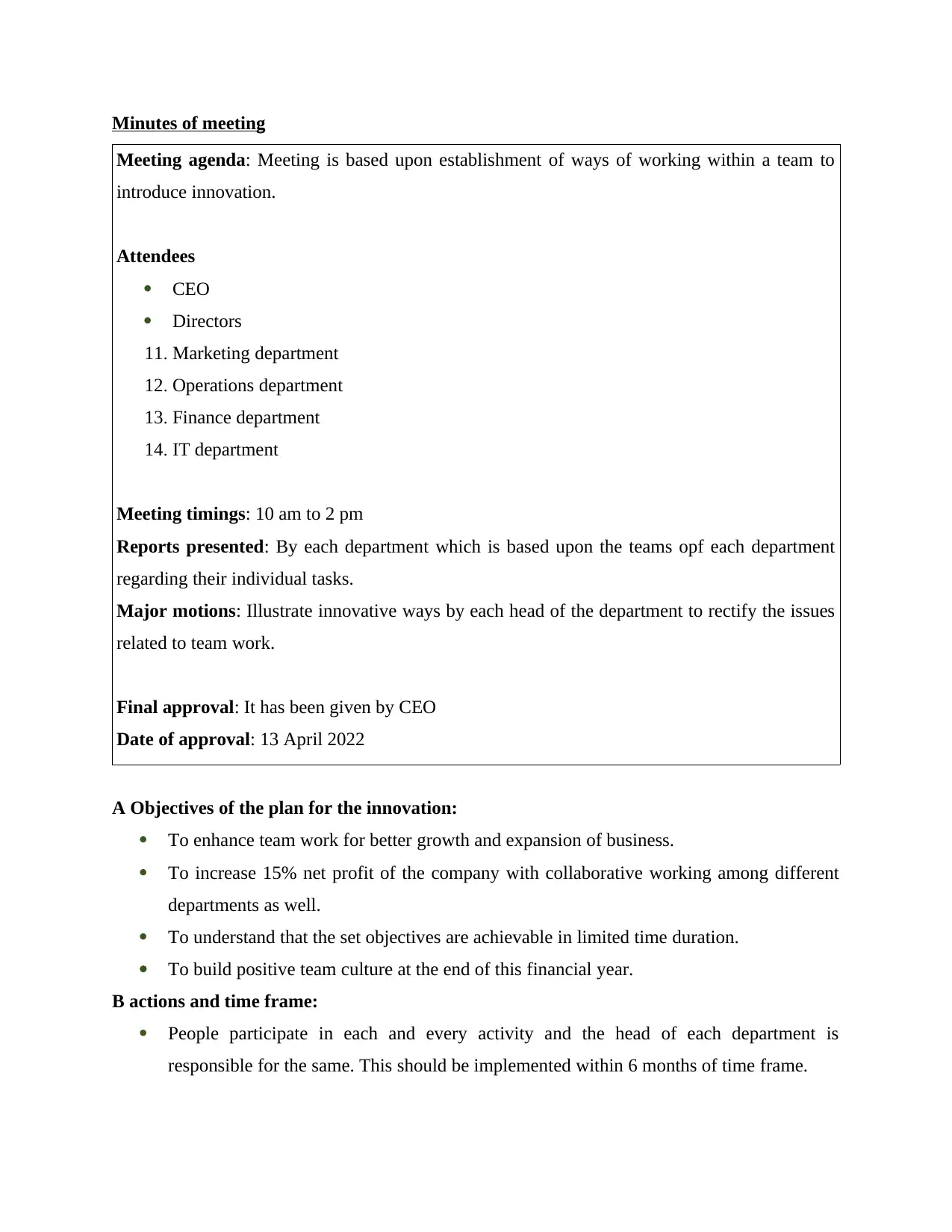
Minutes of meeting
Meeting agenda: Meeting is based upon establishment of ways of working within a team to
introduce innovation.
Attendees
CEO
Directors
11. Marketing department
12. Operations department
13. Finance department
14. IT department
Meeting timings: 10 am to 2 pm
Reports presented: By each department which is based upon the teams opf each department
regarding their individual tasks.
Major motions: Illustrate innovative ways by each head of the department to rectify the issues
related to team work.
Final approval: It has been given by CEO
Date of approval: 13 April 2022
A Objectives of the plan for the innovation:
To enhance team work for better growth and expansion of business.
To increase 15% net profit of the company with collaborative working among different
departments as well.
To understand that the set objectives are achievable in limited time duration.
To build positive team culture at the end of this financial year.
B actions and time frame:
People participate in each and every activity and the head of each department is
responsible for the same. This should be implemented within 6 months of time frame.
Meeting agenda: Meeting is based upon establishment of ways of working within a team to
introduce innovation.
Attendees
CEO
Directors
11. Marketing department
12. Operations department
13. Finance department
14. IT department
Meeting timings: 10 am to 2 pm
Reports presented: By each department which is based upon the teams opf each department
regarding their individual tasks.
Major motions: Illustrate innovative ways by each head of the department to rectify the issues
related to team work.
Final approval: It has been given by CEO
Date of approval: 13 April 2022
A Objectives of the plan for the innovation:
To enhance team work for better growth and expansion of business.
To increase 15% net profit of the company with collaborative working among different
departments as well.
To understand that the set objectives are achievable in limited time duration.
To build positive team culture at the end of this financial year.
B actions and time frame:
People participate in each and every activity and the head of each department is
responsible for the same. This should be implemented within 6 months of time frame.
Secure Best Marks with AI Grader
Need help grading? Try our AI Grader for instant feedback on your assignments.
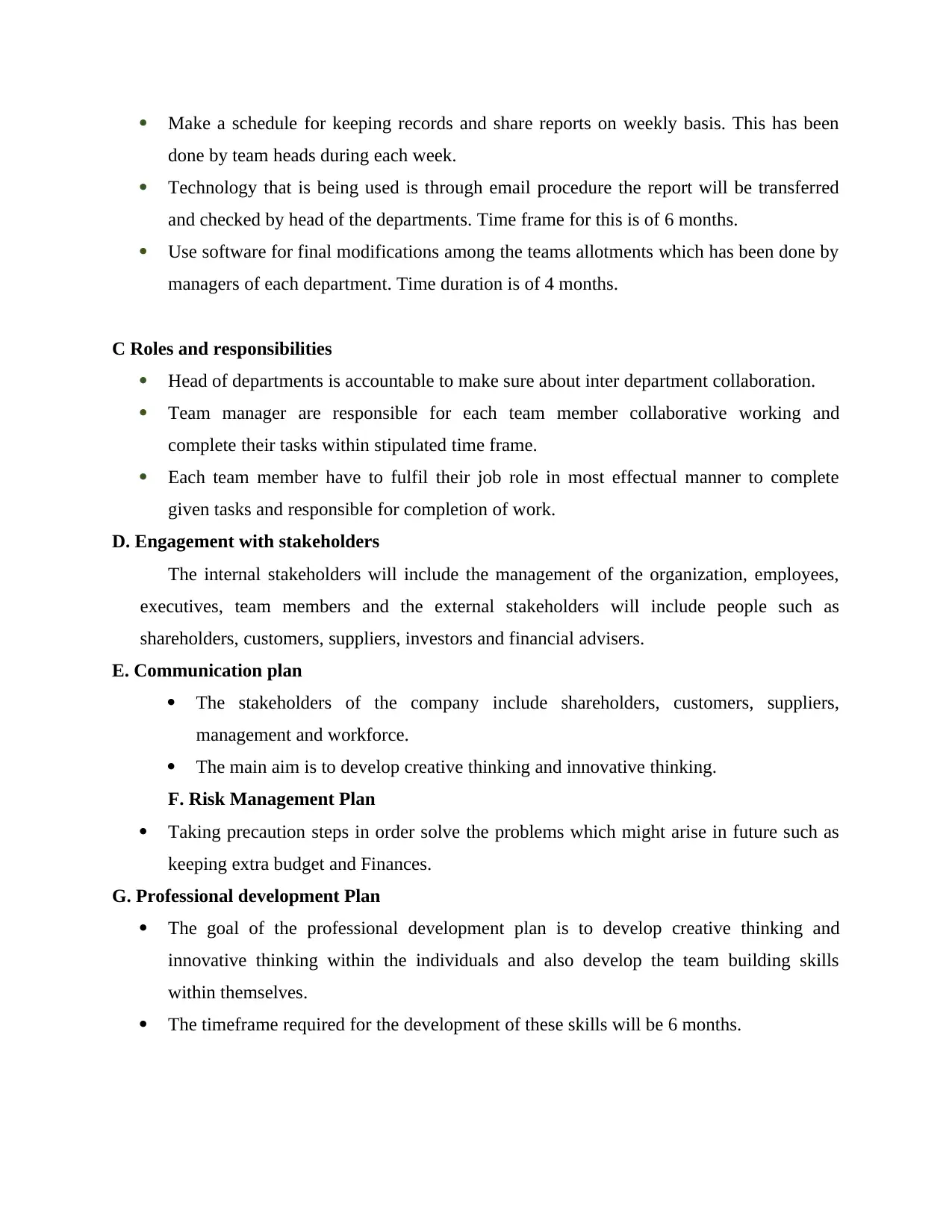
Make a schedule for keeping records and share reports on weekly basis. This has been
done by team heads during each week.
Technology that is being used is through email procedure the report will be transferred
and checked by head of the departments. Time frame for this is of 6 months.
Use software for final modifications among the teams allotments which has been done by
managers of each department. Time duration is of 4 months.
C Roles and responsibilities
Head of departments is accountable to make sure about inter department collaboration.
Team manager are responsible for each team member collaborative working and
complete their tasks within stipulated time frame.
Each team member have to fulfil their job role in most effectual manner to complete
given tasks and responsible for completion of work.
D. Engagement with stakeholders
The internal stakeholders will include the management of the organization, employees,
executives, team members and the external stakeholders will include people such as
shareholders, customers, suppliers, investors and financial advisers.
E. Communication plan
The stakeholders of the company include shareholders, customers, suppliers,
management and workforce.
The main aim is to develop creative thinking and innovative thinking.
F. Risk Management Plan
Taking precaution steps in order solve the problems which might arise in future such as
keeping extra budget and Finances.
G. Professional development Plan
The goal of the professional development plan is to develop creative thinking and
innovative thinking within the individuals and also develop the team building skills
within themselves.
The timeframe required for the development of these skills will be 6 months.
done by team heads during each week.
Technology that is being used is through email procedure the report will be transferred
and checked by head of the departments. Time frame for this is of 6 months.
Use software for final modifications among the teams allotments which has been done by
managers of each department. Time duration is of 4 months.
C Roles and responsibilities
Head of departments is accountable to make sure about inter department collaboration.
Team manager are responsible for each team member collaborative working and
complete their tasks within stipulated time frame.
Each team member have to fulfil their job role in most effectual manner to complete
given tasks and responsible for completion of work.
D. Engagement with stakeholders
The internal stakeholders will include the management of the organization, employees,
executives, team members and the external stakeholders will include people such as
shareholders, customers, suppliers, investors and financial advisers.
E. Communication plan
The stakeholders of the company include shareholders, customers, suppliers,
management and workforce.
The main aim is to develop creative thinking and innovative thinking.
F. Risk Management Plan
Taking precaution steps in order solve the problems which might arise in future such as
keeping extra budget and Finances.
G. Professional development Plan
The goal of the professional development plan is to develop creative thinking and
innovative thinking within the individuals and also develop the team building skills
within themselves.
The timeframe required for the development of these skills will be 6 months.
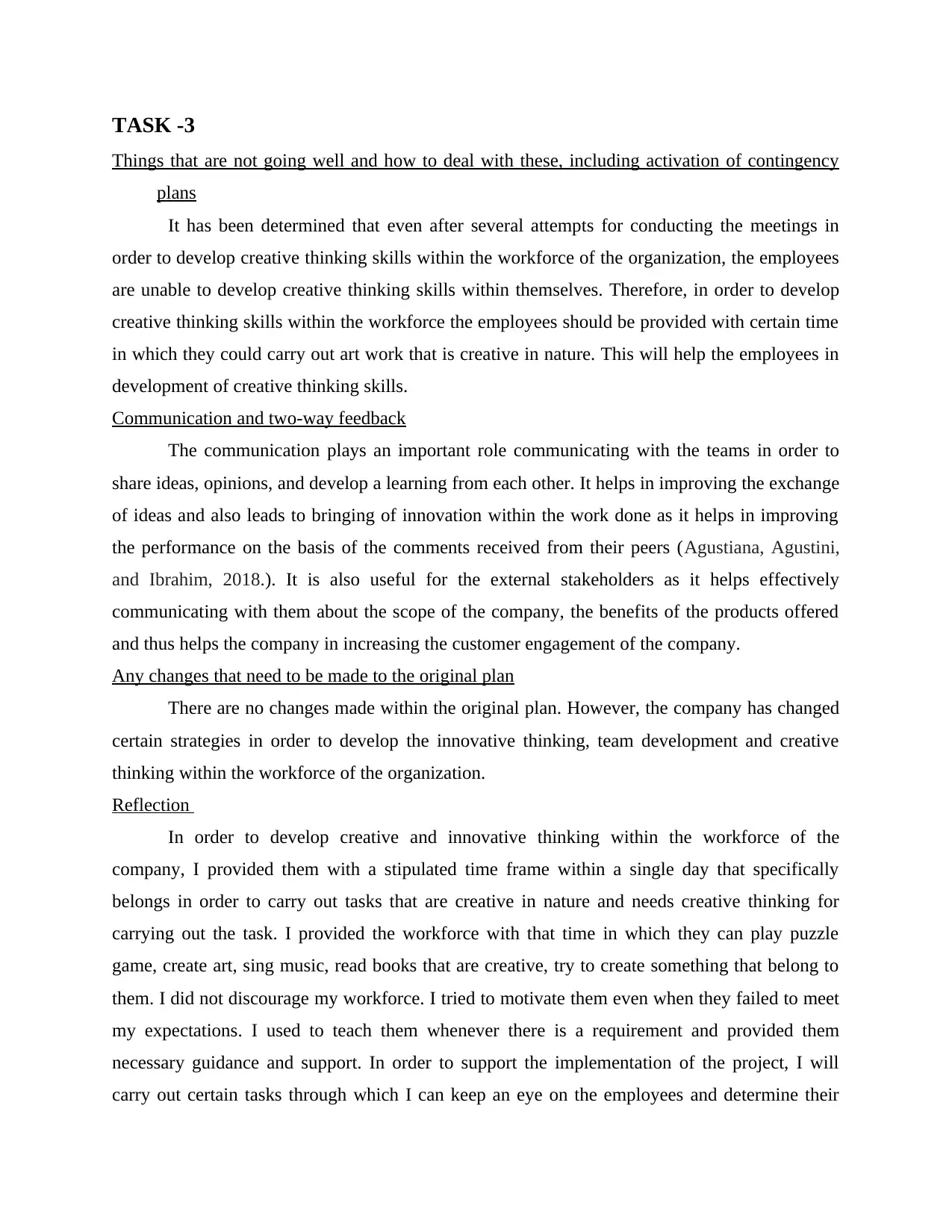
TASK -3
Things that are not going well and how to deal with these, including activation of contingency
plans
It has been determined that even after several attempts for conducting the meetings in
order to develop creative thinking skills within the workforce of the organization, the employees
are unable to develop creative thinking skills within themselves. Therefore, in order to develop
creative thinking skills within the workforce the employees should be provided with certain time
in which they could carry out art work that is creative in nature. This will help the employees in
development of creative thinking skills.
Communication and two-way feedback
The communication plays an important role communicating with the teams in order to
share ideas, opinions, and develop a learning from each other. It helps in improving the exchange
of ideas and also leads to bringing of innovation within the work done as it helps in improving
the performance on the basis of the comments received from their peers (Agustiana, Agustini,
and Ibrahim, 2018.). It is also useful for the external stakeholders as it helps effectively
communicating with them about the scope of the company, the benefits of the products offered
and thus helps the company in increasing the customer engagement of the company.
Any changes that need to be made to the original plan
There are no changes made within the original plan. However, the company has changed
certain strategies in order to develop the innovative thinking, team development and creative
thinking within the workforce of the organization.
Reflection
In order to develop creative and innovative thinking within the workforce of the
company, I provided them with a stipulated time frame within a single day that specifically
belongs in order to carry out tasks that are creative in nature and needs creative thinking for
carrying out the task. I provided the workforce with that time in which they can play puzzle
game, create art, sing music, read books that are creative, try to create something that belong to
them. I did not discourage my workforce. I tried to motivate them even when they failed to meet
my expectations. I used to teach them whenever there is a requirement and provided them
necessary guidance and support. In order to support the implementation of the project, I will
carry out certain tasks through which I can keep an eye on the employees and determine their
Things that are not going well and how to deal with these, including activation of contingency
plans
It has been determined that even after several attempts for conducting the meetings in
order to develop creative thinking skills within the workforce of the organization, the employees
are unable to develop creative thinking skills within themselves. Therefore, in order to develop
creative thinking skills within the workforce the employees should be provided with certain time
in which they could carry out art work that is creative in nature. This will help the employees in
development of creative thinking skills.
Communication and two-way feedback
The communication plays an important role communicating with the teams in order to
share ideas, opinions, and develop a learning from each other. It helps in improving the exchange
of ideas and also leads to bringing of innovation within the work done as it helps in improving
the performance on the basis of the comments received from their peers (Agustiana, Agustini,
and Ibrahim, 2018.). It is also useful for the external stakeholders as it helps effectively
communicating with them about the scope of the company, the benefits of the products offered
and thus helps the company in increasing the customer engagement of the company.
Any changes that need to be made to the original plan
There are no changes made within the original plan. However, the company has changed
certain strategies in order to develop the innovative thinking, team development and creative
thinking within the workforce of the organization.
Reflection
In order to develop creative and innovative thinking within the workforce of the
company, I provided them with a stipulated time frame within a single day that specifically
belongs in order to carry out tasks that are creative in nature and needs creative thinking for
carrying out the task. I provided the workforce with that time in which they can play puzzle
game, create art, sing music, read books that are creative, try to create something that belong to
them. I did not discourage my workforce. I tried to motivate them even when they failed to meet
my expectations. I used to teach them whenever there is a requirement and provided them
necessary guidance and support. In order to support the implementation of the project, I will
carry out certain tasks through which I can keep an eye on the employees and determine their
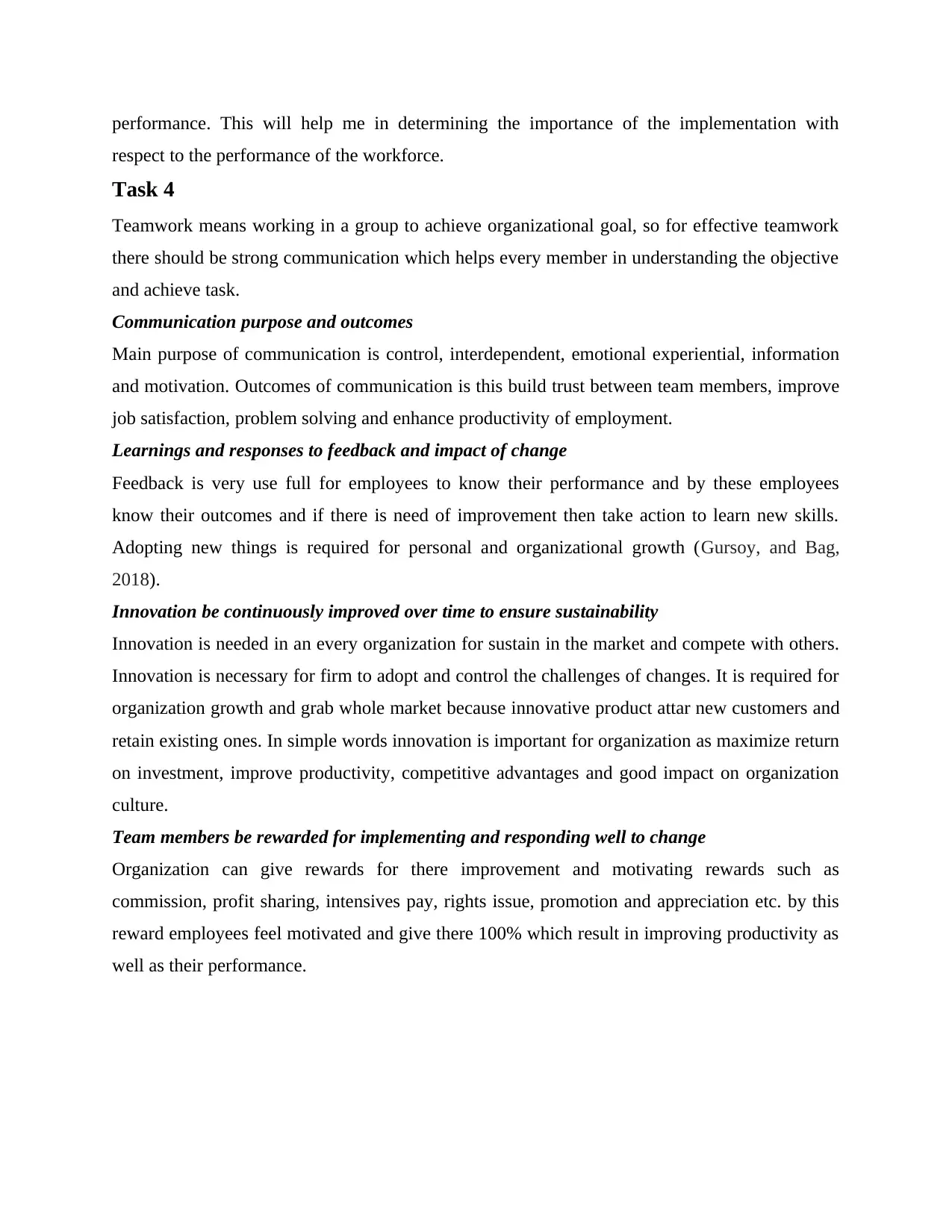
performance. This will help me in determining the importance of the implementation with
respect to the performance of the workforce.
Task 4
Teamwork means working in a group to achieve organizational goal, so for effective teamwork
there should be strong communication which helps every member in understanding the objective
and achieve task.
Communication purpose and outcomes
Main purpose of communication is control, interdependent, emotional experiential, information
and motivation. Outcomes of communication is this build trust between team members, improve
job satisfaction, problem solving and enhance productivity of employment.
Learnings and responses to feedback and impact of change
Feedback is very use full for employees to know their performance and by these employees
know their outcomes and if there is need of improvement then take action to learn new skills.
Adopting new things is required for personal and organizational growth (Gursoy, and Bag,
2018).
Innovation be continuously improved over time to ensure sustainability
Innovation is needed in an every organization for sustain in the market and compete with others.
Innovation is necessary for firm to adopt and control the challenges of changes. It is required for
organization growth and grab whole market because innovative product attar new customers and
retain existing ones. In simple words innovation is important for organization as maximize return
on investment, improve productivity, competitive advantages and good impact on organization
culture.
Team members be rewarded for implementing and responding well to change
Organization can give rewards for there improvement and motivating rewards such as
commission, profit sharing, intensives pay, rights issue, promotion and appreciation etc. by this
reward employees feel motivated and give there 100% which result in improving productivity as
well as their performance.
respect to the performance of the workforce.
Task 4
Teamwork means working in a group to achieve organizational goal, so for effective teamwork
there should be strong communication which helps every member in understanding the objective
and achieve task.
Communication purpose and outcomes
Main purpose of communication is control, interdependent, emotional experiential, information
and motivation. Outcomes of communication is this build trust between team members, improve
job satisfaction, problem solving and enhance productivity of employment.
Learnings and responses to feedback and impact of change
Feedback is very use full for employees to know their performance and by these employees
know their outcomes and if there is need of improvement then take action to learn new skills.
Adopting new things is required for personal and organizational growth (Gursoy, and Bag,
2018).
Innovation be continuously improved over time to ensure sustainability
Innovation is needed in an every organization for sustain in the market and compete with others.
Innovation is necessary for firm to adopt and control the challenges of changes. It is required for
organization growth and grab whole market because innovative product attar new customers and
retain existing ones. In simple words innovation is important for organization as maximize return
on investment, improve productivity, competitive advantages and good impact on organization
culture.
Team members be rewarded for implementing and responding well to change
Organization can give rewards for there improvement and motivating rewards such as
commission, profit sharing, intensives pay, rights issue, promotion and appreciation etc. by this
reward employees feel motivated and give there 100% which result in improving productivity as
well as their performance.
Paraphrase This Document
Need a fresh take? Get an instant paraphrase of this document with our AI Paraphraser

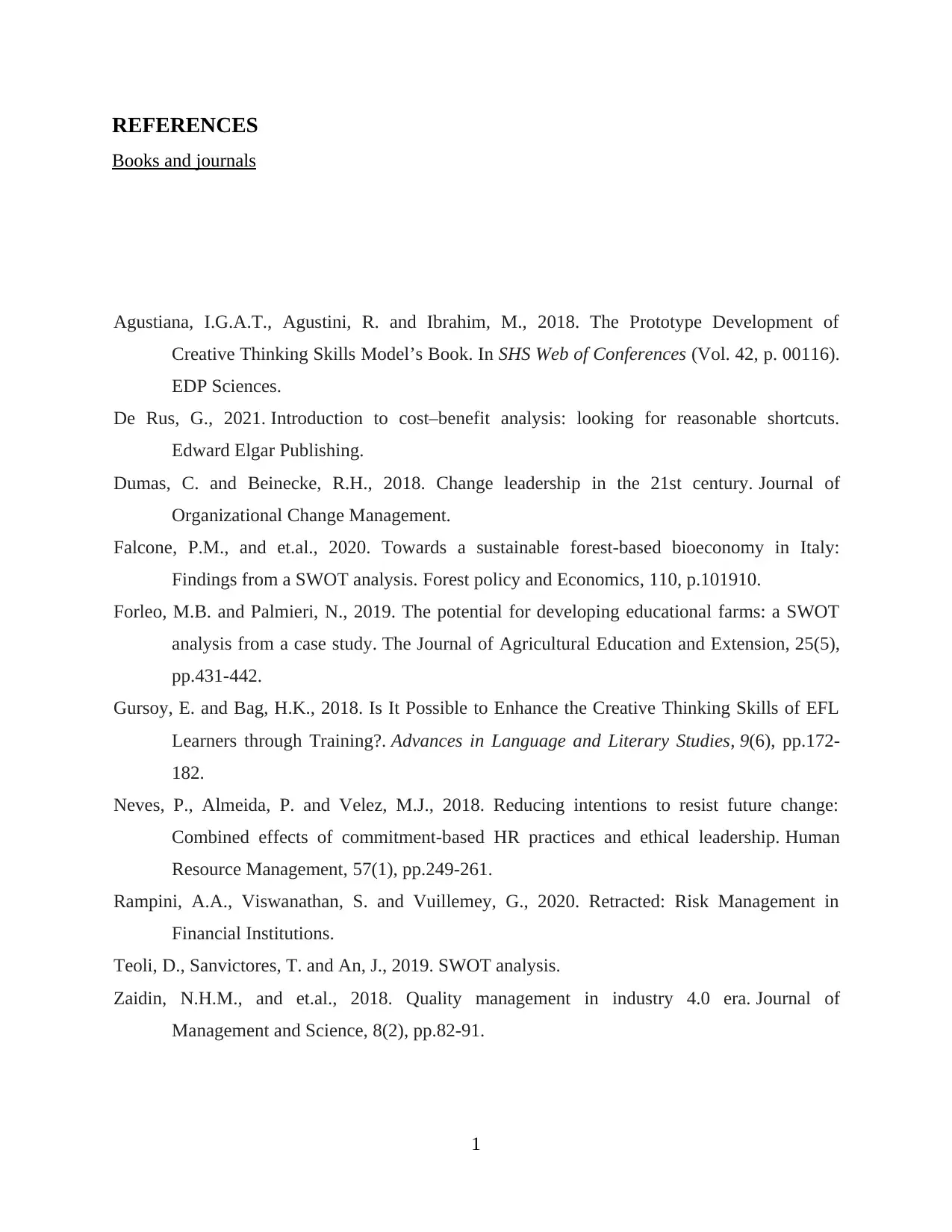
REFERENCES
Books and journals
Agustiana, I.G.A.T., Agustini, R. and Ibrahim, M., 2018. The Prototype Development of
Creative Thinking Skills Model’s Book. In SHS Web of Conferences (Vol. 42, p. 00116).
EDP Sciences.
De Rus, G., 2021. Introduction to cost–benefit analysis: looking for reasonable shortcuts.
Edward Elgar Publishing.
Dumas, C. and Beinecke, R.H., 2018. Change leadership in the 21st century. Journal of
Organizational Change Management.
Falcone, P.M., and et.al., 2020. Towards a sustainable forest-based bioeconomy in Italy:
Findings from a SWOT analysis. Forest policy and Economics, 110, p.101910.
Forleo, M.B. and Palmieri, N., 2019. The potential for developing educational farms: a SWOT
analysis from a case study. The Journal of Agricultural Education and Extension, 25(5),
pp.431-442.
Gursoy, E. and Bag, H.K., 2018. Is It Possible to Enhance the Creative Thinking Skills of EFL
Learners through Training?. Advances in Language and Literary Studies, 9(6), pp.172-
182.
Neves, P., Almeida, P. and Velez, M.J., 2018. Reducing intentions to resist future change:
Combined effects of commitment‐based HR practices and ethical leadership. Human
Resource Management, 57(1), pp.249-261.
Rampini, A.A., Viswanathan, S. and Vuillemey, G., 2020. Retracted: Risk Management in
Financial Institutions.
Teoli, D., Sanvictores, T. and An, J., 2019. SWOT analysis.
Zaidin, N.H.M., and et.al., 2018. Quality management in industry 4.0 era. Journal of
Management and Science, 8(2), pp.82-91.
1
Books and journals
Agustiana, I.G.A.T., Agustini, R. and Ibrahim, M., 2018. The Prototype Development of
Creative Thinking Skills Model’s Book. In SHS Web of Conferences (Vol. 42, p. 00116).
EDP Sciences.
De Rus, G., 2021. Introduction to cost–benefit analysis: looking for reasonable shortcuts.
Edward Elgar Publishing.
Dumas, C. and Beinecke, R.H., 2018. Change leadership in the 21st century. Journal of
Organizational Change Management.
Falcone, P.M., and et.al., 2020. Towards a sustainable forest-based bioeconomy in Italy:
Findings from a SWOT analysis. Forest policy and Economics, 110, p.101910.
Forleo, M.B. and Palmieri, N., 2019. The potential for developing educational farms: a SWOT
analysis from a case study. The Journal of Agricultural Education and Extension, 25(5),
pp.431-442.
Gursoy, E. and Bag, H.K., 2018. Is It Possible to Enhance the Creative Thinking Skills of EFL
Learners through Training?. Advances in Language and Literary Studies, 9(6), pp.172-
182.
Neves, P., Almeida, P. and Velez, M.J., 2018. Reducing intentions to resist future change:
Combined effects of commitment‐based HR practices and ethical leadership. Human
Resource Management, 57(1), pp.249-261.
Rampini, A.A., Viswanathan, S. and Vuillemey, G., 2020. Retracted: Risk Management in
Financial Institutions.
Teoli, D., Sanvictores, T. and An, J., 2019. SWOT analysis.
Zaidin, N.H.M., and et.al., 2018. Quality management in industry 4.0 era. Journal of
Management and Science, 8(2), pp.82-91.
1

2
1 out of 16
Related Documents
Your All-in-One AI-Powered Toolkit for Academic Success.
+13062052269
info@desklib.com
Available 24*7 on WhatsApp / Email
![[object Object]](/_next/static/media/star-bottom.7253800d.svg)
Unlock your academic potential
© 2024 | Zucol Services PVT LTD | All rights reserved.





